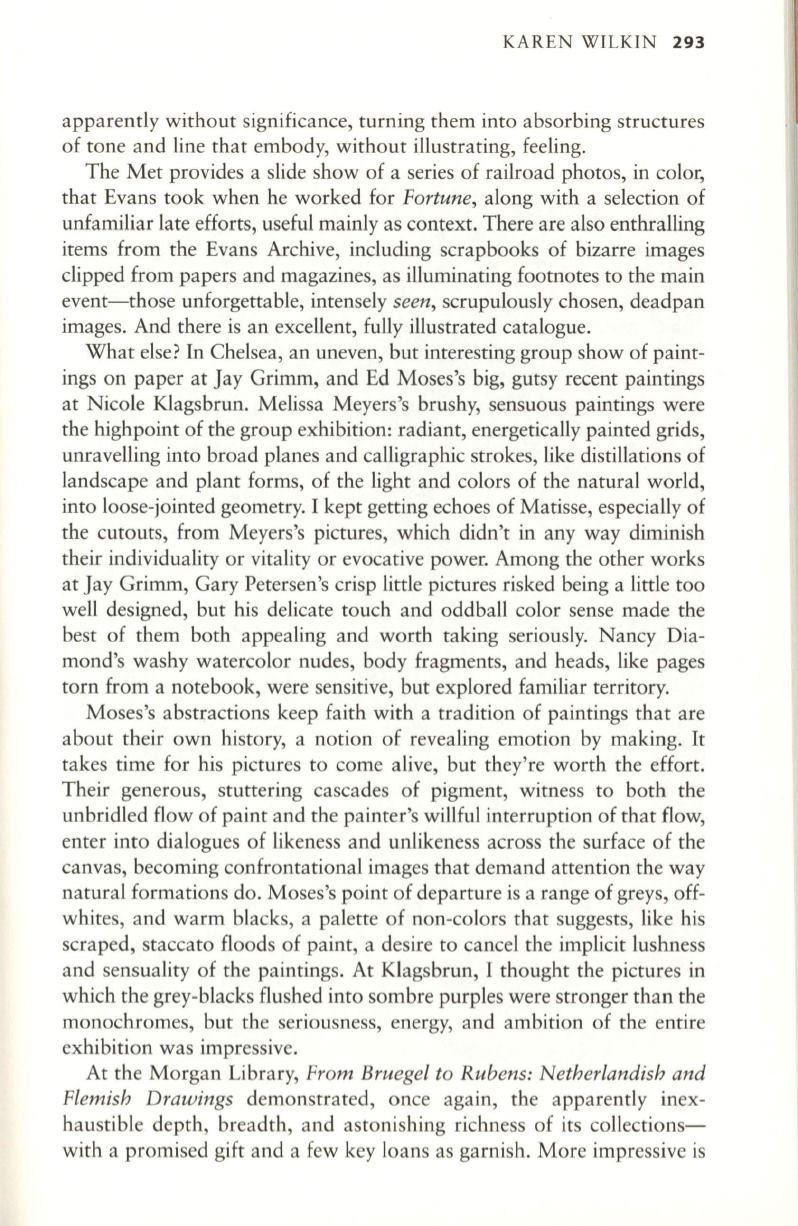
KAREN WILKIN
293
apparently without significance, turning them into absorbing structures
of tone and line that embody, without illustrating, feeling.
The Met provides a slide show of a series of railroad photos, in color,
that Evans took when he worked for
Fortune,
along with a selection of
unfamiliar late efforts, useful mainly as context. There are also enthralling
items from the Evans Archive, including scrapbooks of bizarre images
clipped from papers and magazines, as illuminating footnotes to the main
event-those unforgettable, intensely
seen,
scrupulously chosen, deadpan
images. And there is an excellent, fully illustrated catalogue.
What else? In Chelsea, an uneven, but interesting group show of paint–
ings on paper at Jay Grimm, and Ed Moses's big, gutsy recent paintings
at Nicole Klagsbrun. Melissa Meyers's brushy, sensuous paintings were
the highpoint of the group exhibition: radiant, energetically painted grids,
unravelling into broad planes and calligraphic strokes, like distillations of
landscape and plant forms, of the light and colors of the natural world,
into loose-jointed geometry. I kept getting echoes of Matisse, especially of
the cutouts, from Meyers's pictures, which didn't in any way diminish
their individuality or vitality or evocative power. Among the other works
at Jay Grimm, Gary Petersen's crisp little pictures risked being a little too
well designed, but his delicate touch and oddball color sense made the
best of them both appealing and worth taking seriously. Nancy Dia–
mond's washy watercolor nudes, body fragments, and heads, like pages
torn from a notebook, were sensitive, but explored familiar territory.
Moses's abstractions keep faith with a tradition of paintings that are
about their own history, a notion of revealing emotion by making.
It
takes time for his pictures to come alive, but they're worth the effort.
Their generous, stuttering cascades of pigment, witness to both the
unbridled flow of paint and the painter's willful interruption of that flow,
enter into dialogues of likeness and unlikeness across the surface of the
canvas, becoming confrontational images that demand attention the way
natural formations do. Moses's point of departure is a range of greys, off–
whites, and warm blacks, a palette of non-colors that suggests, like his
scraped, staccato floods of paint, a desire to cancel the implicit lushness
and sensuality of the paintings. At Klagsbrun, I thought the pictures in
which the grey-blacks flushed into sombre purples were stronger than the
monochromes, but the seriousness, energy, and ambition of the entire
exhibition was impressive.
At the Morgan Library,
From Bruegel to Rubens: Netherlandish and
Flemish Drawings
demonstrated, once again, the apparently inex–
haustible depth, breadth, and astonishing richness of its collections–
with a promised gift and a few key loans as garnish. More impressive is


